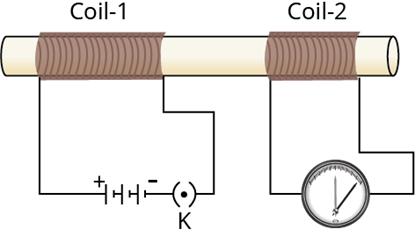
PUMPA - SMART LEARNING
எங்கள் ஆசிரியர்களுடன் 1-ஆன்-1 ஆலோசனை நேரத்தைப் பெறுங்கள். டாப்பர் ஆவதற்கு நாங்கள் பயிற்சி அளிப்போம்
Book Free DemoLet us now perform a activity in which a current-carrying coil replaces the moving magnet, and the current in the coil can be varied.
Steps:
- Take two different coils of copper wire with a large number of turns (say 50 and 100 turns, respectively) and insert them over a non-conducting cylindrical roll, as shown in the below figure (You may use a thick paper roll).

Current is induced in coil-2 when current in coil-1 is changed.
- Connect the coil-1, which has a larger number of turns, in series with a battery and a plug key. Also, connect the other coil-2 with a galvanometer, as shown in the figure.
- Plug in the key. Notice the galvanometer.
Is there a deflection in the galvanometer's needle?
You will see that the needle of the galvanometer and just as , indicating a momentary current in coil-2.
- Disconnect coil-1 from the battery.
You will see that the needle momentarily moves but to the . It indicates that now the current flows in the in coil-2.
Observations:
In this activity, we see that as soon as the current in coil-1 reaches either a steady value or zero, the galvanometer in coil-2 shows .
This activity shows that whenever the electric current through coil–1 changes (starting or stopping), .
Coil-1 and coil-2 are known as the primary and secondary coils, respectively. As the current in the first coil varies, then the corresponding magnetic field . Thus, the magnetic field lines around the secondary coil (coil -2) .